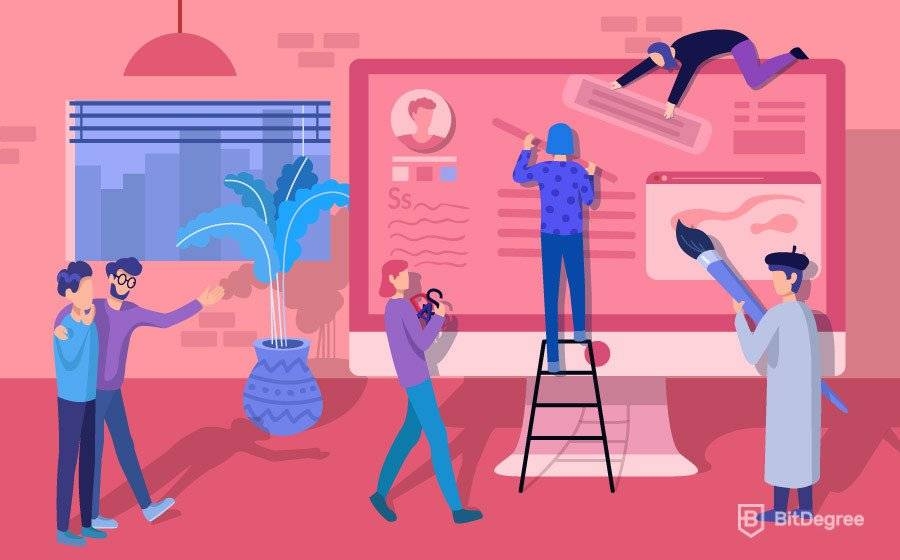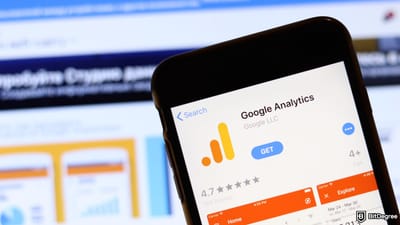Stop overpaying - start transferring money with Ogvio. Sign up, invite friends & grab Rewards now! 🎁
As of late, questions like “how to become a graphic designer?” and “how much do graphic designers make?” are becoming increasingly popular. There seem to be a lot of people who want to learn graphic design, whether it be for their personal goals and projects, or to start building a stable and fun career path.
Whatever the case might be, there are a few key requirements that everyone who wants to know how to be a graphic designer should be aware of. If you’re one of the people who want to start their careers in the field of graphic design - great! You’ve come to the right place!
Table of Contents
Describing the Profession
So then, what is graphic design from a career path perspective? Even though you might already know some of the fundamental information about this profession, it good to have a nice refresh before we begin talking about all of the main criteria for becoming a graphic designer.
Latest DataCamp Coupon Found:First and foremost, graphic design is a creative profession. As the name implies, graphic designers are tasked to create specific, on-demand designs. These designs usually involve website layouts, posters, interface specifics, and so on. As you can probably tell, the profession involves a wide spectrum of possible tasks - they usually depend on the company that the designer works for.
A big part of how to become a graphic designer is understanding, that you’ll have two big options work-wise: either you work in a company, or as a freelancer. This is one of the main perks of the specialty – you can choose whether you want to be a part of a team or work solo. Because of this, you might notice that some of the requirements differ when we start talking about the essential graphic design skills – but more on that later.
Whether you work solo or in a company, one thing’s for sure – people who want to learn graphic design should also pay a lot of attention to their communication skills. No matter what type of a graphic designer you might choose to be, you will always have to be able to negotiate your ideas with a client, find a compromise and, naturally, fulfill your end of the bargain.
So, with that, you now have some basic information about the course laid out. But what about the main requirements to get the job?
How to Become a Graphic Designer?
You can probably understand this yourself, but there are a lot of different requirements that one has to meet if he or she is thinking of becoming a graphic designer. We won’t go through all of them (that would take forever) - instead, let’s talk about the graphic design aspects that are going to be of the utmost importance when you’re trying to get a job.
In this tutorial, we’ll cover three such aspects - education, motivation, and experience. Let’s start with education.
Education
Education is important (duh…) - graphic design is no exception. Even though employers these days have become much more fluid in their hiring process, proper education is still one of the most important requirements when you’re trying to get a decent job in the field of graphic design. There are two ways to go about it.
First of all, you have a formal education. This is the most common type of education that graphic designers have - you go to a college or a university, enroll in a study program that will help you on how to become a graphic designer, study hard and - voila! - you’re a certified graphic designer. That being said, things aren’t as easy as they may look.
One of the most important aspects of your studies is the portfolio. During your years of studying graphic design, you must spend a lot of time (and I do mean - A LOT of time) adding new work to your portfolio. You could say that it’s the most important part of your CV - whenever a wannabe graphic designer goes into a job interview, one of the main things that he or she is going to be judged by is his or her portfolio. Keep this in mind!
Furthermore, if you’re studying in a university or college, and are adamant on learning how to become a graphic designer, you must participate in as many seminars, contests, “after-class” lectures (and everything in between) as possible. This way, you will not only be able to work on your graphic design skills, but will also get your name out there and get noticed. Additionally, these events (especially ones that will grant you some sort of a certification) can be yet another great addition to your CV - if a potential employer sees that you’ve been an active participant in events that are involved in graphic design, they will note that as a good sign. But, more on that when we talk about the motivation side of things.
Another alternative for education is to study and learn independently. This has been an ever-growing phenomenon among people who want to learn how to become a graphic designer, especially those who are planning to work as freelancers.
One good thing about learning how to be a graphic designer individually is that you get the chance to plan your own time, and might even start to freelance, accordingly. Even if you decide to take online courses, most of them are going to have a super-flexible timetable, thus allowing you to study additional learning and practice material on your own. If it so happens that finances are a bit low at the moment, you shouldn't forgo your dream: try applying for scholarships for online classes. You can learn about the process here.
Also, even though things were very different five or ten years ago, these days employers are much more flexible with their hiring etiquette. If formal education (a university diploma) used to be a must back in the day, now things are much more open-ended. Your character and personality are going to be equally as important as your skills and portfolio - do keep that in mind!
Motivation
Even though motivation is more of a subjective point to analyze, it’s still just as important as any other one.
Whenever you’re searching for how to become a graphic designer, you will find that motivation can be a very broad topic - it doesn’t only mean “wanting to do something”. A motivated graphic designer is a person who is constantly embracing both of their creative and marketing sides. Becoming a graphic designer means being able to think of unique and original ideas that would also be successful marketing-wise. That’s a tough nut to crack - often you will find yourself in a situation where you love the idea of the design, but it will simply not “sell”. This is why a 360-degree type of motivation is important - you have to be able to dismiss unwanted and ineffective designs, and quickly come up with new ideas.
Your motivation will show as soon as you walk into the job interview. If your potential employers are already veterans of the industry, they will quickly and easily see whether or not you truly are interested in work that will teach you how to become a graphic designer.
Motivation doesn’t only start and end with the interview, however. After becoming a graphic designer, you will have to prove yourself (and your motivation) to your new employers. Whether it be simple, entry-level tasks, or some sort of a test system, one thing’s for certain - the company will be keeping its eye on you, and if you managed to fake your motivation during the interview, well… Let’s just say that you’re probably going to have a bad time.
So, to sum up - if you want to be a graphic designer, keep in mind that motivation doesn’t only mean “wanting to do something”. Motivation is doing that “something” - and doing it with a passion.

- Easy to use with a learn-by-doing approach
- Offers quality content
- Gamified in-browser coding experience
- Free certificates of completion
- Focused on data science skills
- Flexible learning timetable

- High-quality courses
- Nanodegree programs
- Student Career services
- Nanodegree programs
- Suitable for enterprises
- Paid certificates of completion

- A wide range of learning programs
- University-level courses
- Easy to navigate
- University-level courses
- Suitable for enterprises
- Verified certificates of completion
Experience
Finally, let’s talk about the experience. This is often a rough topic since the majority of people who are looking for how to become a graphic designer have no experience in the field. Or so they think.
Even though we’re used to associating the word “experience” with the concept of “past work”, this doesn’t always have to be the case. You can be an experienced graphic designer simply by having a lot of participation under your belt. The above-mentioned seminars, courses, projects, groups and everything else truly does add up.
That being said, there are a lot of job positions these days that are aimed at entry-level (beginner) graphic designers. Sure, these jobs might not be your dream career, and they will most likely offer a pretty low salary (by comparison). However, they are going to be perfect for you experience-wise - you will have the opportunity to start slow, and build your skills and knowledge from there on out.
Finally, people who want to learn graphic design should also keep in mind that freelancing is also considered as a valid, legitimate experience. Sure, your skills have to represent your freelance work, but many employers will think that you are probably very disciplined and strict, if you’ve managed to pull off freelancing work. This is mostly because a lot of freelancers get a little bit too relaxed with the whole “I’m my own boss” concept, and they flunk their freelancing careers, altogether.
Why Become a Graphic Designer?
There are a few big reasons for why a person would be motivated to learn graphic design. The very first thing that comes to people’s minds is the creativity that is involved with this job. A graphic designer has to be creative - this is bliss for artistic people who want to see their designs published (printed, hung, etc.) for everyone to see.
Since graphic design is one of those professions that allow a work-from-home type of scenario, you can manage your time much more effectively. If an office and a team just aren’t the things for you - no worries! Furthermore, once you learn how to become a graphic designer, a huge career path opens up in front of you. Individual freelance work is a common sight among graphic designers. That being said, you have to work hard to earn a name within the industry - it’ll probably take much more effort than building a reputation within a company.
Finally, the graphic designer salary is also something that may attract a lot of people to this specialty. Glassdoor.com states that the average salary of a graphic designer is $45,677 per year or almost $3806 per month. Keep in mind, this is only concerning the graphic designers that work in companies - it would be impossible to say how much freelancers make since they all have their own, individual pricing options. Whatever the case might be, making over $3800 per month doing something you love ain’t shabby!

Did you know?
Have you ever wondered which online learning platforms are the best for your career?
Is This Your Path?
By now, you should not only know the essentials of how to become a graphic designer but also have some thorough knowledge about the profession itself. You should be now ready to start your journey into the world of graphic design. If you need more resources, courses to learn, be sure to check out BitDegree's Graphic Design section. And remember, even if you have financial difficulties, there is a way to get your courses.
Best of luck in your career path to come!








